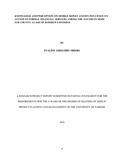| dc.description.abstract | Access to Formal Financial services remain of interest to many especially in the developing countries. This is because it does not only benefit the individuals but also contribute to the overall growth and development in a nation. The challenge of access to formal financial services is accelerated by poor infrastructures especially in rural areas of Kenya, coupled with distance to the formal financial providers and the cost related to operating the bank accounts. Serving the poor with financial services remains a challenge to the formal financial institutions due to expenses involved with low profitability. The purpose of this study was therefore to investigate knowledge and perception on mobile money and its influence on access to formal financial services. The main objectives of the study were, to examine the extent to which perception on the mobile money influences access to formal financial services, to establish the extent to which knowledge on the use of mobile money influenced access to formal financial services, to examine the extent to which cost effectiveness of mobile money usage influenced access to formal financial services and to establish how access to mobile phone influenced the relationship between youth knowledge and perception on mobile money and access to formal financial services. The study targeted 375 youths between 18 to 35 years of age residing within Kombewa division of Seme Sub County. It also targeted the formal financial service players serving the sub county. A descriptive survey design was employed in the study. The data was collected using both closed and open ended questionnaires and interview schedules. Validity of the instrument was ensured by structuring the questions in line with the study objectives, supervisor and peer review of the tool. Reliability of the instrument was assured through internal consistency technique using the Kuder-Richardson (K-R)20 formula. Analysis involved descriptive statistics for the quantitative data and qualitative data was transcribed and organized in themes and reported. There was a moderate significant positive correlation between perception on mobile money and access to formal financial services, r= 0.440, p<0.001(1-tailed), CL=95%. A strong significant positive correlation was established between knowledge on mobile money and access to formal financial services, r= 0.675, p<0.001(1-tailed), CL=95%.A very weak insignificant positive correlation was evident between cost effectiveness of mobile money and access to formal financial services, r= 0.193, p=0.003(1-tailed), CL=95%.It found that there was weak significant positive correlation between access to mobile phones and access to formal financial services ,r= 0.373, p<0.001(1-tailed), CL=95%.It was concluded that that sensitization on mobile phones and use to enhance knowledge would enhance access to formal financial services for the youth residents of Kombewa Division. It was also concluded that persuading favorable perception on mobile money would enhance access to formal financial services for youth residents of Kombewa Division. It was concluded that mobile money was cost effective for the youth residents in Kombewa Division. It was also inferred that making mobile money more cost effective would enhance access to formal financial services for the youth residents in Kombewa Division albeit to a small extent. It was also inferred that improving access to mobile phone among the youth in Kombewa Division would enhance access to formal financial services among the youth in the Division though to a small extent. The mobile service providers should also heighten the sensitization to enhance knowledge on mobile money, they should strive to further enhance favorable perceptions on mobile money and reduce transaction costs a little to improve access to formal financial service among the youth residents of Kombewa Division. | en_US |



